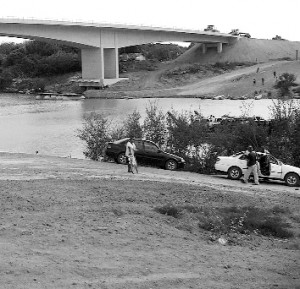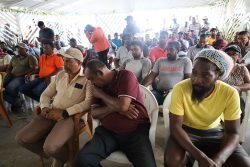A trade imbalance in favour of Brazil and security issues continue to be of concern to the business community at Lethem as Guyana and Brazil put finishing touches to the Takutu Bridge and other infrastructure and facilities.
The commissioning of the bridge is tentatively set for July 23, 2008.
 The business community at Lethem still feels that more needs to be done in terms of educating people on the benefits of the Guyana/Brazil Partial Scope Agreement and the list of eligible items of trade, since there are concerns that the balance of trade would continue to favour Brazil.
The business community at Lethem still feels that more needs to be done in terms of educating people on the benefits of the Guyana/Brazil Partial Scope Agreement and the list of eligible items of trade, since there are concerns that the balance of trade would continue to favour Brazil.
With the opening of the bridge, the business community would also like the authorities in both countries to reach agreement on security measures which would facilitate the exchange of information on stolen property taken across the border, and allow for arrangements for its return.
Asked for an update on the status of the bridge, Brazil’s ambassador to Guyana Arthur VC Meyers told Stabroek News that based on information he had received the bulk of the work was essentially completed and he expected the governments of both countries would be looking at a possible date in June for its inauguration.
Meyers, who was scheduled to attend the presidential summit of the Union of South American Nations (UNASUR) in Brasilia on Friday said he expected President Bharrat Jagdeo and Brazil’s President Luis Inacio Lula da Silva, who were to attend the summit would discuss developments surrounding the commissioning of the bridge. This was one of several projects Lula had committed his government to completing and which was seen as a vital link to the Atlantic for the Brazilian land-locked state of Roraima.
While Meyers said that based on information received the bridge could be inaugurated next month, the Guyana government’s chief engineer Walter Willis told Stabroek News that while the bridge itself might be ready there were still some outstanding works to be completed at the Guyana end.
He felt that to ensure all systems were in place a July month-end date was more practicable.
He said that at present, the teams were working towards a July 23 date, but that was not set in stone and the technical teams of both countries were now due to meet in Bom Fin in Brazil this week to look at the general progress of the project.
The bridge, Willis said, was substantially completed, the rails installed and the approaches to both sides of the bridges built. In addition, two culverts were being built to accommodate the right hand/left hand drive changeover. (Brazil has right-hand drive and Guyana has left-hand drive traffic.)
At the Brazil end, Meyers said the neighbouring country was in the process of completing arrangements for customs and immigration and other needed facilities at Bom Fin for the processing of travel and trade.
He said that the issue of motor vehicular insurance was still engaging the attention of both countries. He expected Brazilian motor insurance experts would be in Guyana in early June to work with their counterparts on initialling an agreement in this regard.
Brazilian vice-consulate
Brazil was also in the process of opening a vice-consulate at Lethem in time for the commissioning of the bridge, he said. This would be another step in strengthening bilateral relations as it was expected that the flow of people and cargo between the two countries would grow significantly. “I am quite confident that bilateral trade will flourish after the inauguration of the bridge,” he told this newspaper.
Meanwhile, Lethem businessman Don Melville told Stabroek News that the bridge, which was impressive looking and changed the landscape significantly, appeared to be completed with people walking and riding across the span regularly. The Brazilian army vehicles are the only vehicles allowed on the bridge. The work on the bridge, undertaken by more than one Brazilian contractor, was supervised by the engineering corps of the Brazilian army.
Secretary-General of Brazil’s Ministry of External Relations Samuel Pinheiro Guimaraes Neto gave the assurance on a visit here that the army had built many roads and bridges in Brazil and had highly qualified people with long experience in construction on these types of projects.
According to Melville, the pontoon was still in use ferrying vehicles and travellers across the Takutu River which separates Guyana and Brazil.
Not ready for trade
From the business point of view, Melville did not feel that Guyana was ready for trade with Brazil, contending that the Partial Scope Agreement did not benefit Guyana as it might benefit Brazil since trade continued to be lop-sided.
“People in Lethem are not aware of what the agreement offers. Maybe the people in Georgetown know better,” he said, pointing to an “urgent need for those in this part of the world to know how we could benefit from it. Trade is one-way with the Brazilians supplying everything basically.”
Melville said that Brazilians came across the border mainly to buy shoes and T-shirts and limited quantities of foodstuff. “They can’t carry much of anything because anything above the quota allocated would be deemed as contraband and they would be seized if caught,” he said, adding that the only way they could get back their stuff was if they paid the import duties, which in his opinion, were prohibitive. “The Brazilian federal police don’t take bribes,” he said.
In early April, Minister of Foreign Trade and International Cooperation, Dr Henry Jeffrey had issued a call for businesses and potential exporters to add new products to the current list of products, including pharmaceuticals, which may be eligible for export to Brazil with the opening of the bridge.
The Partial Scope Agreement comes to an end on May 31, 2008 but it is expected that it would be extended for another two years and the list of products eligible for trade between the two countries would be expanded.
In terms of security, Melville expressed the hope that with the opening of the bridge there would be enhanced security on both sides of the border with operational procedures for the arrest of thieves who cross the frontier and the return of stolen property to its owners.
Cattle-rustling
He noted that cattle-rustling continued to be a problem with the perpetrators coming mainly from the Brazilian side. He related that three weeks ago his family lost 25 head of cattle to rustlers from Brazil and reported the incident to the local police and to the Brazilian police also.
Even though they admitted that the perpetrators were in Brazil, he said they contended that the crime was committed in Guyana and there was nothing they could do. “The attitude over there is that they can’t help,” he said.
He recalled, too, that three years ago the Dadanawa ranch lost about 300 head of cattle to Brazilian cattle rustlers. “I don’t know if they can’t help or they don’t want to help,” he said, but mechanisms should be in place for the two police forces to assist in fighting and solving crimes in border areas since both jurisdictions were affected.
With the opening of the bridge and enhanced relations, he said that the two governments needed to find a way to recover and return the animals. The bandits, he said, came across the border with high-powered weapons, while the Guyanese have none to protect themselves. “The people’s monies are on the savannahs… in their cattle,” he continued, and the two governments must find a way to protect them.
Given the inability of the police on both sides of the border to help each other’s nationals in solving the problem of cattle-rustlers Melville wondered whether other property would be affected with improved means of trans-border communication.
On the road link from Lethem to Georgetown, Willis said that the Omai operations were maintaining the road from the turn-off point at Omai to Linden, while Mekdeci construction company was maintaining the road north of Kurupukari for a stretch of 15 miles and the stretch of road south of Kurupukari to Lethem.
He said that the bridges were still a source of concern, but they were being repaired or maintained on a “case-by-case” basis.
Meanwhile, work on the multi-purpose building to accommodate customs, immigration and the police, and departments of the ministries of health, agriculture, tourism and a trade administration division in keeping with the Partial Scope Agreement is almost completed, and offices have already been assigned.
Willis said that there was still one major partition to be completed and two exits to the building were being built. Meanwhile, the offices are being furnished by the respective departments and agencies.
With the opening of the bridge, the Georgetown-Lethem road would be linked to the road from Bom Fin to Boa Vista to form part of the Initiative for the Integration of Regional Infrastructure in South America (IIRSA).
The Takutu Bridge is one of 335 projects identified by IIRSA – which is part of an initiative of South American governments to construct a new infrastructural network for the continent. The network includes roads, bridges, waterways, ports and energy and communications interconnections.
Work on the bridge resumed in April 2007, six years after it had ceased because of financial irregularities and after an initial start-up. In February 2005 Brazil’s President Luis Inacio Lula da Silva made a pledge in Guyana’s parliament to have the bridge completed by the end of the same year.









